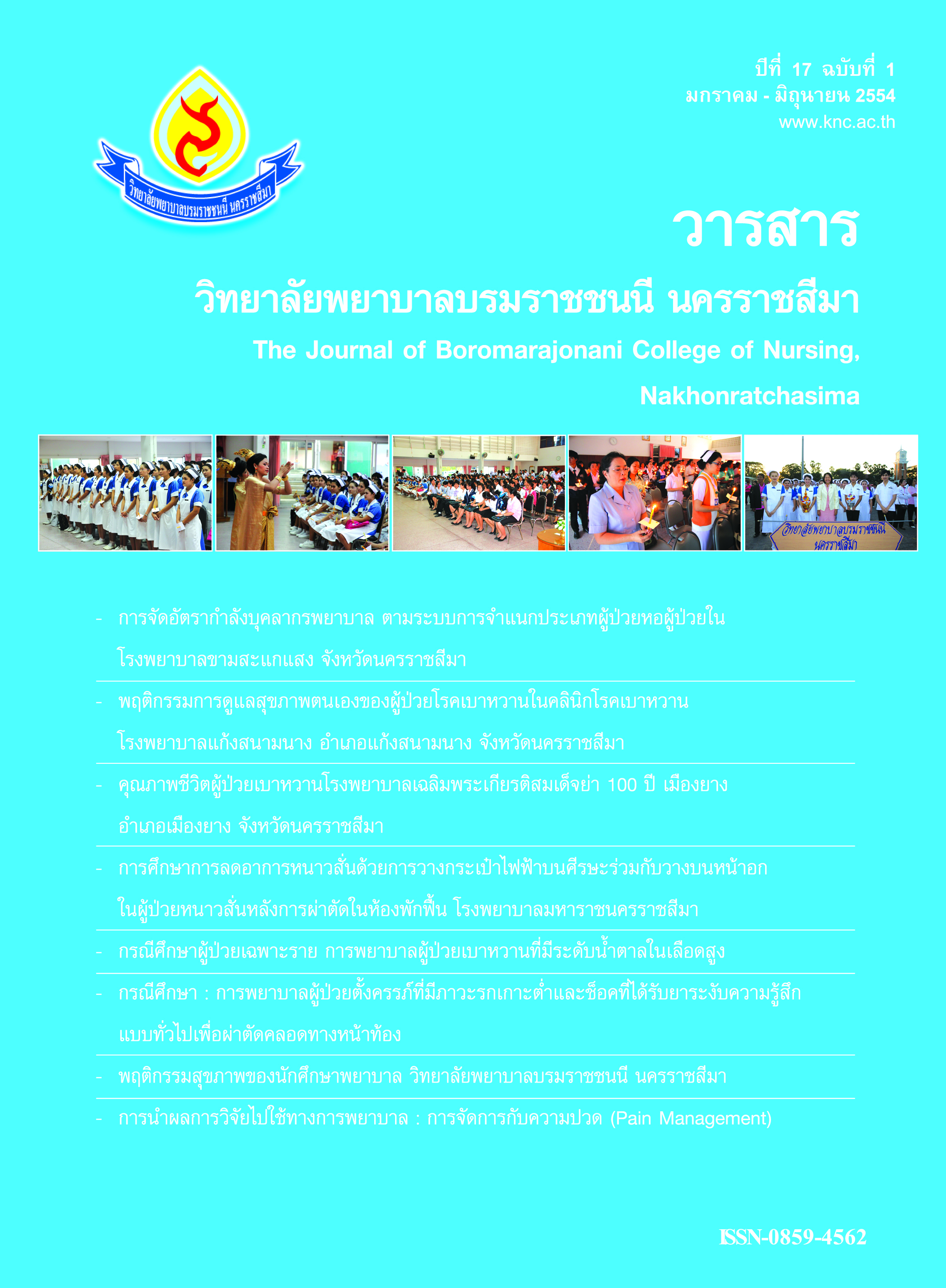คุณภาพชีวิตผู้ป่ วยเบาหวานโรงพยาบาลเฉลิมพระเกียรติสมเด็จย่า 100 ปี เมืองยาง อำเภอเมืองยาง จังหวัดนครราชสีมา
คำสำคัญ:
คุณภาพชีวิต, เบาหวาน, Diabetes Melitus, Quality of Lifeบทคัดย่อ
บทคัดย่อ
เบาหวานเป็นโรคที่มีผลกระทบต่อสุขภาพและคุณภาพชีวิตของผู้ป่วย การวิจัยเชิงสำรวจนี้เป็น การศึกษาเปรียบเทียบคุณภาพชีวิตผู้ป่วยเบาหวานจำแนกตามข้อมูลลักษณะส่วนบุคคล กลุ่มตัวอย่าง คือผู้เป็นเบาหวานที่มารักษาที่โรงพยาบาลเฉลิมพระเกียรติสมเด็จย่า 100 ปี เมืองยาง จำนวน 233 คน ซึ่งได้มาจากวิธีการสุ่มอย่างง่าย เก็บรวบรวมข้อมูลโดยใช้แบบสอบถามคุณภาพชีวิตผู้ป่วยเบาหวานที่ ผู้วิจัยพัฒนาขึ้นเป็นแบบวัดมาตรประมาณค่า 5 ระดับ จำนวน 19 ข้อ ทดสอบความเชื่อมั่น ในผู้ป่วย เบาหวาน จำนวน 30 ราย ได้ค่าสัมประสิทธิ์ ครอนบาคแอลฟาเท่ากับ .77 วิเคราะห์ข้อมูลด้วยสถิติ เชิงพรรณา และสถิติทดสอบ ที และการวิเคราะห์ความแปรปรวนทางเดียว และเปรียบเทียบรายคู่ด้วยวิธี Scheffe’s ผลการวิจัยพบว่า ผู้ป่วยเบาหวานส่วนใหญ่เป็นเพศหญิง (ร้อยละ 76.8) อายุ 60 ปี ขึ้นไป (ร้อยละ 49.8) มีสถานภาพสมรสคู่ (ร้อยละ 79.8) จบระดับประถมศึกษา (ร้อยละ 81.1) ประกอบอาชีพเกษตรกร (ร้อยละ 71.2) มีรายได้ครอบครัวต่ำกว่า 5,000 บาท/เดือน (ร้อยละ 83.3) ระยะเวลาการเป็นเบาหวานต่ำ กว่า 5 ปี (ร้อยละ 50.2) และควบคุมระดับน้ำตาลได้ดี (ร้อยละ 56.7) และมีคุณภาพชีวิตในภาพรวมอยู่ใน ระดับค่อนข้างดี (M = 3.65, SD = 0.35) ผลการทดสอบสมมติฐาน พบว่า ผู้ป่วยเบาหวานที่มีเพศ และ รายได้ครอบครัวต่างกันมีคุณภาพชีวิตแตกต่างกันอย่างมีนัยสำคัญทางสถิติ ( t = 2.09, p = .038; F = 5.37, p = .005, ตามลำดับ) ส่วนผู้ที่มีอายุ สถานภาพสมรส ระดับการศึกษา อาชีพ ระยะเวลาการเป็นเบาหวาน และระดับน้ำตาลในเลือดต่างกันมีคุณภาพชีวิตไม่แตกต่างกัน ดังนั้งผู้ที่รับผิดชอบดูแลผู้ป่วยเบาหวานควร จัดโครงการหรือกิจกรรมเพื่อพัฒนาคุณภาพชีวิตผู้ป่วยเบาหวานโดยคำนึงถึงเพศและรายได้ครอบครัวของ ผู้ป่วยเบาหวานเป็นสำคัญ
คำสำคัญ : คุณภาพชีวิต, เบาหวาน
Abstract
Diabetes mellitus (DM) is a chronic disease whose complications can affect peoples’ quality of life (QoL). The purpose of this survey study was to investigate the QoL of the persons with DM by comparing different demographic and clinical characteristics. A random sampling technique was used to recruit 233 persons with DM receiving care at Muangyang Hospital, Nakhonratchasima. The data were collected using a 5-level Likert-type rating scale to measure the QoL of the persons with DM. The scale was developed from previous research and was found to have an acceptable reliability (Cronbach’s alpha of .77) in this study. The data were analyzed using descriptive statistics, t-test, and one-way Anova with Scheffe’s post hoc analysis. The findings have shown that the majority of the sample were female (76.8%), 60 years or older (49.8%), married (79.8%), primary school educated (81.1%), in agriculture (71.2%), with family monthly income of less than 5,000 bath (83.3%), diagnosed with DM less than 5 years (50.2%) and had good blood sugar control (56.7%). Overall, the QoL of the sample was good (3.65 0.35, out of 5). Statistically significant differences in QoL were found among patients with different gender and income (t = 2.09, p .038; F = 5.37, p = .005, respectively) but not among those with different age, marital status, education level, occupation, duration of illness, and blood sugar control. The results suggest that health care providers for the persons with DM should set programs and activities to improve their QoL by taking differences in gender and income into account.
Keywords : Diabetes Melitus, Quality of Life
ดาวน์โหลด
ฉบับ
ประเภทบทความ
สัญญาอนุญาต
บทความที่ได้รับการตีพิมพ์เป็นลิขสิทธิ์ของ วารสารสุขภาพและการศึกษาพยาบาล ซึ่งดำเนินการโดยวิทยาลัยพยาบาลบรมราชชนนี นครราชสีมา
ข้อความที่ปรากฏในบทความในวารสารเล่มนี้เป็นความคิดเห็นส่วนตัวของผู้เขียนแต่ละท่านไม่เกี่ยวข้องกับกองบรรณาธิการวารสารสุขภาพและการศึกษาพยาบาล หรือวิทยาลัยพยาบาลบรมราชชนนี นครราชสีมา แต่อย่างใด ความรับผิดชอบองค์ประกอบทั้งหมดของบทความแต่ละเรื่องเป็นของผู้เขียนแต่ละท่าน หากมีความผิดพลาดใดๆ ผู้เขียนแต่ละท่านจะรับผิดชอบบทความของตนเองแต่ผู้เดียว







